
Cnemidophorus is a genus of lizards in the family Teiidae. Species in the genus Cnemidophorus are commonly referred to as whiptail lizards or racerunners. The genus is endemic to South America, Central America, and the West Indies.

Aspidoscelis is a genus of whiptail lizards in the family Teiidae.

The western whiptail is a species of lizard in the family Teiidae. The species is found throughout most of the southwestern United States and northern Mexico. Most of its populations appear stable, and it is not listed as endangered in any of the states comprising its range. It lives in a wide variety of habitats, including deserts and semiarid shrubland, usually in areas with sparse vegetation; it also may be found in woodland, open dry forest, and riparian growth. It lives in burrows. Major differences between this species and the checkered whiptail include the lack of enlarged scales anterior to the gular fold and the presence of enlarged postantebrachial scales. It was previously known as Cnemidophorus tigris, until phylogenetic analyses concluded that the genus Cnemidophorus was polyphyletic. Since it does not migrate, a number of forms have developed in different regions, several of which have been given subspecific names – for example the California whiptail, Aspidoscelis tigris munda.
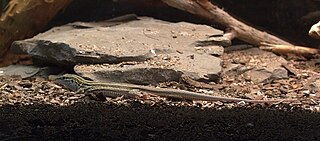
The desert grassland whiptail lizard is an all-female species of reptiles in North America. It was formerly placed in the genus Cnemidophorus. A common predator of the whiptail lizard is the leopard lizard, that prey on A. uniparens by using ambush and stalk haunting tactics. These reptiles reproduce by parthenogenesis. In this process, eggs undergo a chromosome doubling after meiosis, developing into lizards without being fertilized. However, ovulation is enhanced by female-female courtship and mating (pseudo-copulation) rituals that resemble the behavior of closely related species that reproduce sexually.

The Texas spotted whiptail is a species of long-tailed lizard, in the family Teiidae. The species is endemic to the south central and southwestern United States and northern Mexico. Six subspecies are recognized as being valid.

The gray checkered whiptail, also known commonly as Dixon's whiptail and the gray-checkered whiptail, is a species of lizard in the family Teiidae. The species is native to northern Mexico, and to the United States in southern New Mexico and western Texas.

The Laredo striped whiptail is a species of lizard found in the southern United States, in Texas, and northern Mexico in Coahuila, Nuevo Leon, and Tamaulipas. Some sources believe it to be the result of extensive hybridization between the Texas spotted whiptail, Aspidoscelis gularis and the six-lined racerunner, Aspidoscelis sexlineatus. It is one of many lizard species known to be parthenogenic.

The New Mexico whiptail is a female-only species of lizard found in the southwestern United States in New Mexico and Arizona, and in northern Mexico in Chihuahua. It is the official state reptile of New Mexico. It is one of many lizard species known to be parthenogenetic. Individuals of the species can be created either through the hybridization of the little striped whiptail and the western whiptail, or through the parthenogenetic reproduction of an adult New Mexico whiptail.

The six-lined racerunner is a species of lizard native to the United States and Mexico.
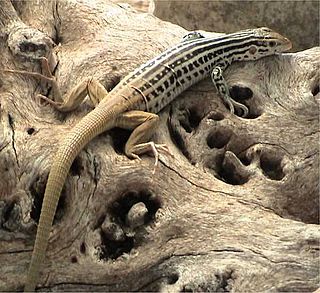
The little striped whiptail is a species of lizard found in the southwestern United States and in northern Mexico. A significant amount of research was done on the species during the mid-1990s, with several new subspecies being added, many of which some sources consider to be distinct enough to warrant full species status, and the research is ongoing. It is called little to distinguish it from many other species known as striped whiptails and to indicate that it is the smallest of those species.

The Argentine black and white tegu, also known as the Argentine giant tegu, the black and white tegu, or the huge tegu, is a species of lizard in the family Teiidae. The species is the largest of the "tegu lizards". It is an omnivorous species which inhabits the tropical rain forests, savannas and semi-deserts of eastern and central South America.

Parthenogenesis is a natural form of asexual reproduction in which growth and development of embryos occur in a gamete without combining with another gamete. In animals, parthenogenesis means development of an embryo from an unfertilized egg cell. In plants, parthenogenesis is a component process of apomixis. In algae, parthenogenesis can mean the development of an embryo from either an individual sperm or an individual egg.
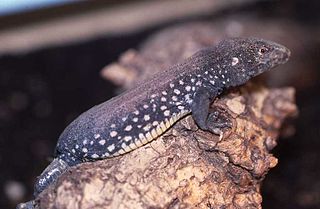
The Saint Lucia whiptail, also known commonly as the Maria Islands whiptail, the Saint Lucian whiptail, and Vanzo's whiptail, is a species of lizard in the family Teiidae. The species is indigenous to the Caribbean.
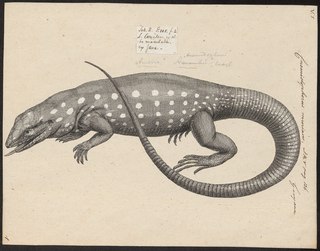
Cnemidophorus murinus, known commonly as Laurenti's whiptail, is a species of lizard in the family Teiidae (whiptails). The species is endemic to Curacao, and is oviparous.
Parthenogenesis is a mode of asexual reproduction in which offspring are produced by females without the genetic contribution of a male. Among all the sexual vertebrates, the only examples of true parthenogenesis, in which all-female populations reproduce without the involvement of males, are found in squamate reptiles. There are about 50 species of lizard and 1 species of snake that reproduce solely through parthenogenesis. It is unknown how many sexually reproducing species are also capable of parthenogenesis in the absence of males, but recent research has revealed that this ability is widespread among squamates.
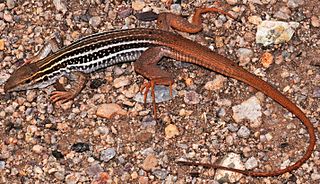
The canyon spotted whiptail is a species of lizard in the family Teiidae. The species is native to northwestern Mexico and the adjacent southwestern United States.

Aspidoscelis costatus, also known as the western Mexico whiptail, is a species of whiptail lizard endemic to Mexico, including Guerrero, Morelos, and Puebla in southern Mexico, as well as other Mexican states. Its range spans both temperate and tropical habitats, and even densely populated urban areas. Its common name, the Western Mexico Whiptail, can easily be confused with the Western Whiptail, which refers to a different lizard, Aspidoscelis tigris.
Aspidoscelis danheimae, also known commonly as the Isla San José whiptail, the San Jose Island blue-throated whiptail, and el huico de la Isla San José in Spanish, is a species of lizard in the family Teiidae. The species is endemic to Isla San José in Baja California Sur, Mexico.
Aspidoscelis rodecki, also known commonly as Rodeck's whiptail, is a species of lizard in the family Teiidae. The species is endemic to Mexico.














